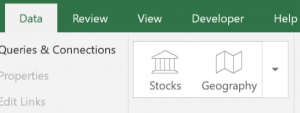New Data Types in Excel
Excel adds AI capabilities to recognize rich data types beyond numbers and text strings

What becomes possible if Excel evolved to a world where cells weren’t limited to just a single, flat, piece of text, but could instead hold a far richer concept?
About New Data Types in Excel
With added AI capabilities, Excel can now recognize rich data types beyond numbers and text strings. For example, Excel recognizes that “France” is a country and automatically associates it with additional attributes such as population and gross domestic product.
These attributes can then be populated into different cells or used directly in formulas and stay updated with the latest data. Based on machine learning, these new data types will simplify the process of working with real-world data. In the future, we’ll add organizational data types backed by the Microsoft Knowledge Graph to Excel—intelligently enhancing your spreadsheets with even richer content.
This journey starts with Stocks and Geography as the first two AI-powered data types, which will help users quickly turn complex data into action.
The new data types are being released as preview to Office 365 subscribers enrolled in the Office Insiders program, in the English language only, starting in April 2018. Read more detail in this blog post.


Journey
The new data types in Excel feature demonstrates how teams from across the company contribute to build something quite amazing –a showcase of One Microsoft at work, and a shining example of the not-so-spontaneous combustion that can come from the simple process of using a hackathon to explore an idea.
InstaFact, the 2016 Hackathon Grand Prize winner, was a perfect storm of right project, right place, right time, and became a catalyst between multiple teams to take the concept of pulling rich data into Excel to the next level.
InstaFact, a Hackathon project
InstaFact was created as an Office add-in to integrate the Satori knowledge graph into Word and Excel to help people save time, work more easily and be more productive by quickly retrieving the information they need. The main idea was to help users solve their information needs without the need of switching context and applications. The team who created InstaFact were part of the Satori team and already had deep understanding of knowledge graphs and how they work. The hackathon was used as focus time to crack the code of surfacing rich data in Word and Excel through a knowledge graph.
InstaFact allowed people to access data from the knowledge graph in their Word documents and Excel spreadsheets. For example, when a user wrote a sentence such as “Peyton Manning played for” in Word, Instafact immediately provided the information Indianapolis Colts and Denver Broncos. Similarly, when a user input a few names such as Labrador, Boxer, Brittany, Chihuahua, and Yorkshire in the cells of a row or column in an Excel spreadsheet, the backend AI disambiguation engine figured out that the names in this example refer to dog breeds.
This allowed the user to retrieve information instantly about the height, weight, fur color, and other breed characteristics by using natural language in the table header, and then use the full power of Excel to examine the data retrieved from the graph.
The roots of Project Yellow
Way back when going to the library was still the best way to get information, Simon Peyton Jones, Microsoft Research in Cambridge, UK, wrote a thought leadership paper. As with many ideas way out in front of technology, his paper was in the annals of interesting ideas whose time had not yet come.
Fast forward 18 years, where John Campbell and Christian Canton were leading a small group working with customers and incubating new Excel scenarios. Through yellow highlighted interview notes, a theme emerged — the idea of integrating richer datatypes that could express complex ideas as a value. With the vast quantities of information available, Simon’s idea was now within reach. In parallel, Silviu Cucerzan from Microsoft Research in Redmond, Washington, was pioneering technology for entity detection and linking, which has been adopted in the past 12 years by numerous Microsoft products and won several academic competitions. InstaFact for Excel brought to light a novel scenario of using this technology in conjunction with the enormous quantity of knowledge harvested and stored by Satori that could change the way people are searching for facts and accessing information.
How it all came together
A collaboration ensued while refining the vision, and the Excel team was funded for Project Yellow. Right about this time, InstaFact was busy winning the second annual global Hackathon. Through winning the hackathon and the subsequent meeting with the CEO — the reward for winning over thousands of hackathon projects — the visibility of this project caught the attention of the Project Yellow team and provided a solid proof of concept.
To bring Project Yellow to life, the team had to bring together multiple organizations and technologies to deliver the end-to-end solution of bringing new data types into Excel.
- The Excel team provided native integration with the app, calculations, and changes to the formula language to support the vision.
- The User Content and Insights team in Office provided Skydance, which is a new service that sends strings to the knowledge graph and a user interface that allows a user to curate the knowledge graph’s results to provide deep insights.
- The Satori team provided the intelligence and data packaging. This includes NEMO, a powerful disambiguation engine that was built in Microsoft Research and further developed by the Satori group.
- The MSN team provided financial data from Stocks; one of the hero scenarios of the first release.
The result? A feature in Excel for Office 365 customers who are part of Office Insiders.
Team

InstaFact Hackathon team (left to right): Srivatsava Daruru, Rohit Paravastu, Silviu Cucerzan, Rajeev Kumar, Deepak Zambre
Teams working on components of Project Yellow
People who contributed may not be listed, however their contribution is deeply appreciated.
Press
New in March—rich data types, intelligent search, and expanded datacenters
Microsoft 365 Blog
Preview of Stocks and Geography, New Data Types in Excel
John Campbell, Microsoft
Microsoft to add new geography, stocks data types to Excel
ZDNet
Excel is getting smarter
Tech Crunch
Microsoft Excel adds AI-powered data types for places and stocks
Venture Beat
Microsoft brings new AI-powered data types to Excel
Windows Central
